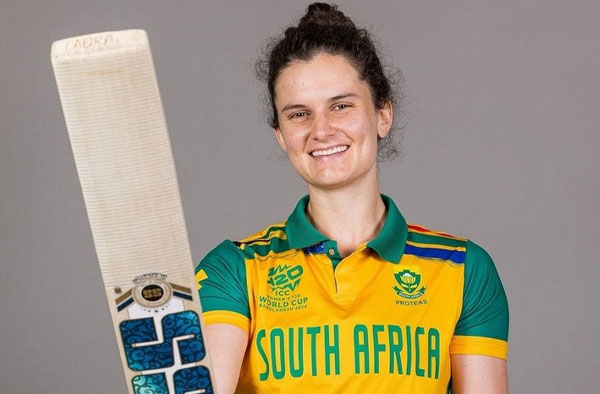The ICC Women’s T20 World Cup 2024 has concluded, with New Zealand achieving their first-ever title, and South Africa once again left heartbroken after a second consecutive final defeat. While team glory went to the White Ferns, individual brilliance was on full display throughout the tournament. From aggressive openers to match-winning bowlers, these 11 players formed the backbone of their teams and made the ICC’s Team of the Tournament. Let’s dive into the standout performers who shaped the World Cup.
Laura Wolvaardt (South Africa)

Wolvaardt’s leadership as captain translated seamlessly into her batting as she dominated the tournament. The leading run-scorer with 223 runs at an average of 44.60, Wolvaardt’s performances were a masterclass in consistency and composure. Her highest score came in South Africa’s opening game against the West Indies, where she anchored the chase with an unbeaten 59 off 55. In the semi-final against Australia, her measured 42 ensured South Africa’s successful pursuit.
Tazmin Brits (South Africa)
Brits complemented Wolvaardt perfectly, forming one of the most reliable opening partnerships of the tournament. Amassing 187 runs across six matches, Brits maintained an impressive average of 37.40, which made her the second-highest run-scorer of the World Cup. Her standout innings came in South Africa’s opener, where her unbeaten 57 off 52 balls secured a vital win against the West Indies. Brits’ ability to rotate strike and accelerate when needed made her a crucial cog in the South African top order.
Danni Wyatt-Hodge (England)

Wyatt-Hodge played her role as an explosive opener with authority, accumulating 151 runs from four matches at a strike rate of 124.79. She brought England’s innings to life, starting with a solid 41 off 40 against Bangladesh. Wyatt-Hodge’s crowning performance came in England’s penultimate group match against Scotland, where she smashed an unbeaten 51 off just 26 balls, propelling her team to a comfortable 10-wicket victory. Wyatt-Hodge’s aggressive approach often put the opposition on the back foot, making her a pivotal figure in England’s campaign.
Amelia Kerr (New Zealand)
New Zealand’s star all-rounder, Amelia Kerr, was the undisputed Player of the Tournament, excelling with both bat and ball. Kerr contributed 135 runs with the bat and took 15 wickets with her leg-spin, becoming the tournament’s leading wicket-taker. Her ability to perform under pressure was evident in the final, where she scored a crucial 43 off 38 and delivered match-winning bowling figures of 3 for 24. Kerr’s all-round brilliance was on full display throughout the campaign, especially in her best bowling spell of 4 for 26 against Australia in the group stage.
Harmanpreet Kaur (India)
India’s captain once again proved her mettle on the world stage, finishing as India’s top scorer with 150 runs from four matches. Her staggering average of 150 and a strike rate of 133.92 highlighted her ability to lead from the front. Kaur’s two half-centuries were pivotal to India’s campaign – a quickfire 52* off 27 balls against Sri Lanka and the season best of 54* off 47 against Australia – keeping the team in the hunt for a semi-final spot.
Deandra Dottin (West Indies)
Returning to international cricket with a bang, Dottin played a crucial role for the West Indies. Her 120 runs at a tournament-best strike rate of 162.16 showcased her destructive power. Dottin’s ability to clear the ropes, evidenced by the tournament-high nine sixes, made her the most feared middle-order batter. In addition to her batting, Dottin contributed with the ball, taking five wickets, including a standout performance of 4 for 22 in the semi-final against New Zealand.
Nigar Sultana Joty (Bangladesh)
Bangladesh’s wicketkeeper-batter was one of the standout performers for her side, both behind the stumps and with the bat. Joty scored 104 runs in four innings at an average of 34.66, with her best knock being a solid 39 off 44 balls against the West Indies. However, it was her glovework that set her apart, as she led the tournament in dismissals with six stumpings and one catch. Joty’s sharp reflexes and flawless execution with the gloves played a crucial role in Bangladesh’s progress.
Afy Fletcher (West Indies)
Afy Fletcher’s remarkable consistency with the ball helped the West Indies make it deep into the tournament. The experienced leg-spinner finished with 10 wickets, the third-highest tally in the World Cup. Fletcher’s key moments came in the form of two three-wicket hauls, including a stellar 3 for 21 in the virtual quarter-final against England. In the semi-final, Fletcher showed her all-round ability by picking up two vital wickets and chipping in with a fighting 17* off 15 balls. Her contributions at crucial moments made her a standout bowler in the tournament.
Megan Schutt (Australia)
Megan Schutt’s impact in the tournament was significant as she became the all-time leading wicket-taker in Women’s T20 World Cup history, with 48 wickets. Schutt’s mastery of swing and seam bowling made her a constant threat, and she picked up eight wickets in total. Her best performance came in Australia’s group match against eventual champions New Zealand, where she dismantled their batting order with a sensational 3 for 3. Schutt’s ability to deliver under pressure reaffirmed her position as one of the most reliable pacers in the women’s game.
Rosemary Mair (New Zealand)
The 25-year-old New Zealand quick was one of the key architects of her team’s title-winning campaign. Mair finished with 10 wickets, the most by any pace bowler, consistently troubling batters with her accuracy and swing. Her standout spell came in New Zealand’s opening win against India, where she took 4 for 19 to stifle the Indian batting line-up. Mair also played a crucial role in the final, taking 3 for 25 to put the brakes on South Africa’s innings. Mair’s ability to deliver in high-pressure moments made her a valuable asset for the White Ferns.
Nonkululeko Mlaba (South Africa)
Mlaba’s brilliant left-arm spin was key to South Africa’s journey to the final. She finished as the tournament’s second-highest wicket-taker, with 12 wickets at an average of 11.33. Mlaba announced herself with a stunning 4 for 29 in South Africa’s opener against the West Indies, setting the tone for her team’s campaign. Her ability to take crucial wickets, such as dismissing Australia’s Tahlia McGrath in the semi-final, and Suzie Bates and Amelia Kerr in the final, proved vital in South Africa’s success.
Eden Carson (New Zealand) – 12th player
Eden Carson’s off-spin was instrumental in New Zealand’s successful campaign, with the bowler consistently delivering in clutch moments. Carson’s nine wickets in the tournament included key dismissals that often broke the back of opposition teams. In the semi-final against the West Indies, Carson’s spell of 3 for 29, where she removed three of the top four batters, was crucial in guiding her team to the final. Her control in the powerplay and middle overs made her a crucial strike bowler for the White Ferns.

Loves all things female cricket